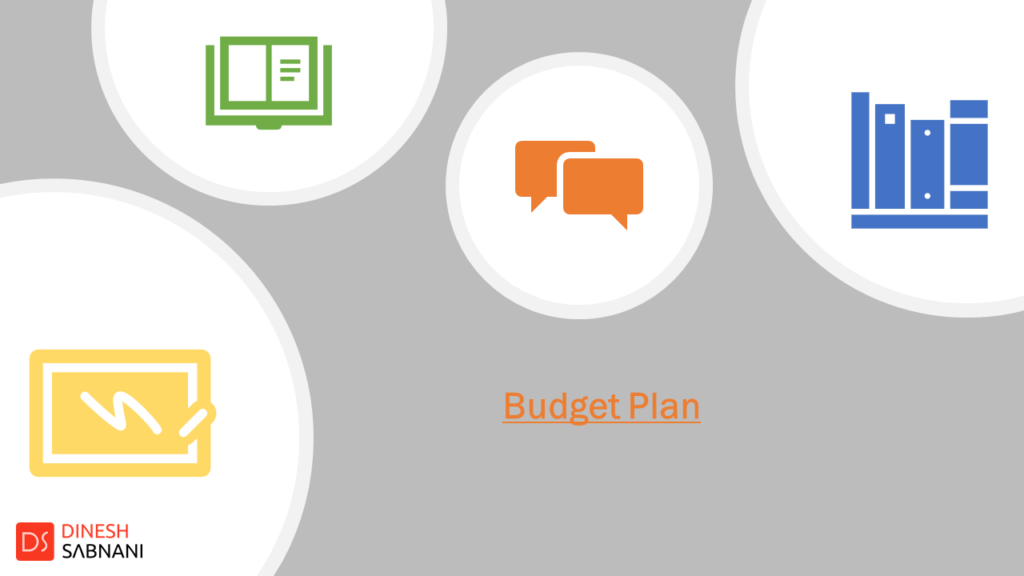Thank you very much for coming back to see the next step in Project Management. Project Management becomes very interesting when your skin is in the game. It becomes intriguing, when you get into the rhythm of it. I hope you have already pulled up your socks to get started with this blog.
Let’s continue with the story of our friend John and the Project being managed for Mr. Smith. With the learnings of last 2 blog, at present, John has figured out about the Scope, WBS and Schedule of the Project.
Now, he is thinking about How to plan the budget?
In this blog, we are going to talk about Budget Plan. The Budget Plan is nothing but, planning the budget expenditure or consumption throughout the project. The project manager prepares the budget plan and adjust it as per the need But before getting into budget planning lets first understand about Project Life Cycle and see how Project Life Cycle and Budget Planning concepts can go hand in hand.
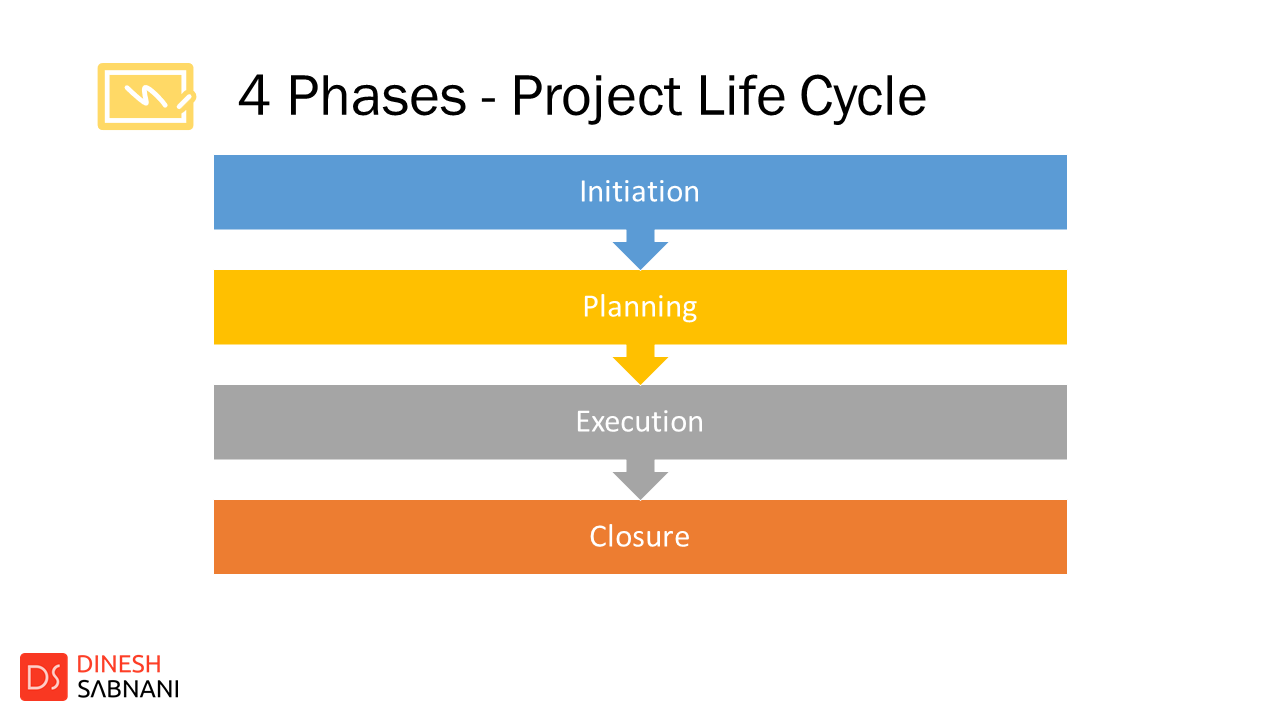
Before beginning the project, The Goal of the project is decided and various solutions are considered in order to build the project. After right solution is chosen the project is signed and Project Manager is assigned.
From beginning till the end generally a project crosses 4 Phases – these are Initiation, Planning, Execution and Closure. This is a proven path and it is referred as Project Life Cycle.
In Initiation Phases – As a project manager you receive information about the project. Information such as Problem Statement, Objective, Major Deliverables, High Level Budget and Group of People identified for working on the project. Project manager do conducts the meetings to meet the stakeholder and brief about the project.
In Planning Phase – Project Manager take all the details and begin planning for Scope, Time and Cost. The initial RAID Log is prepared as the project planning is started and Project manager adds the Risks and Issues which are already foreseen for the project during solution scaping. Also, Communication plan is created to start and maintain the rhythm of regular communication within the project team.
In Execution Phases – the Implementation starts. The activities are performed by the Resources assigned. Team is fully involved in building and integrating different parts of the project. Project Manager maintain and control all the aspects, make sure the activities are completed on time so as steady progress in project is achieved. Project Status reports are prepared to keep Stakeholders and Sponsors informed about the progress. The Plan is updated on regular intervals based on real time progress being made in the project.
Lastly, in Closure – all the deliverables finalized are released to the customer, resources are releases and make sure all payment is received. Project Team gathers the learnings from the project and share with team
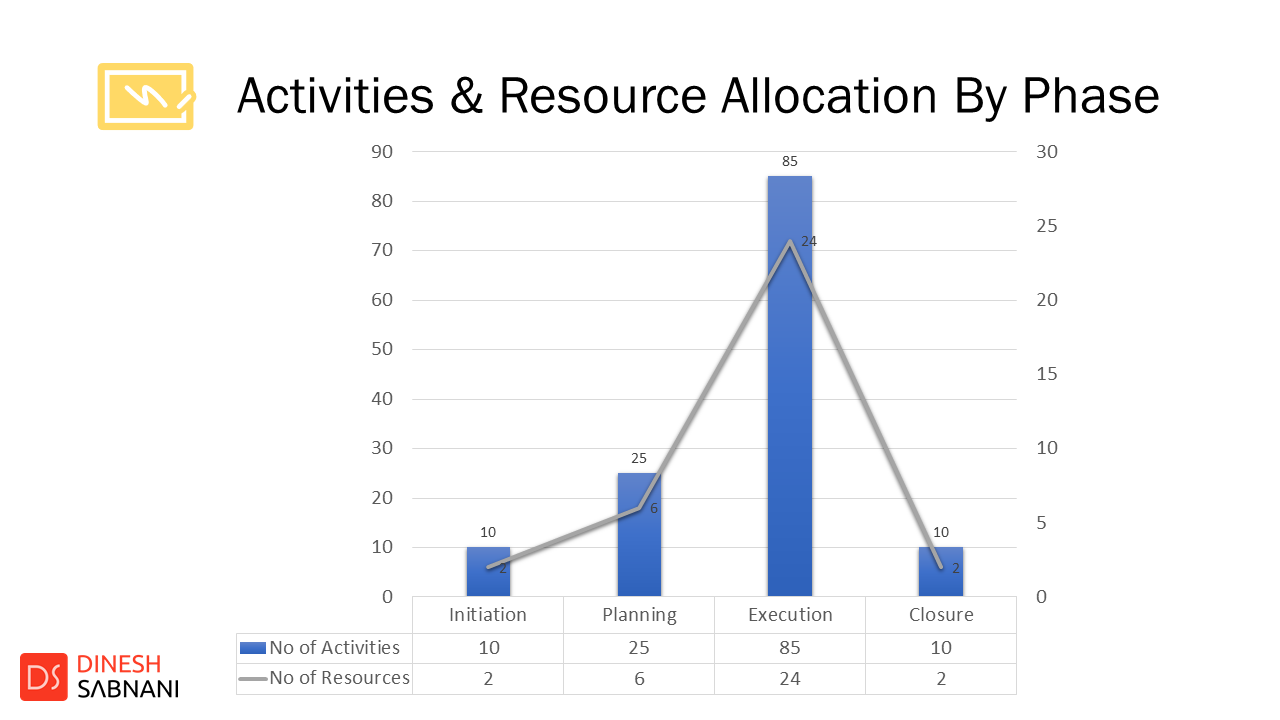
Let’s visualize the Activities and Resource Allocation By Phase.
We need to quantify the Activities to be performed in the project and Quantify the no. of resources required. If we plot them together in the graph, you will observe the activities performed during execution phase are maximum and Initiation and Closure Phases have minimum no. of activities. Same applies to the no. of resources also. You will need more no. of resources in execution phase as compared to other phases.
For resource allocation, In Initiation, Project manager and few important stakeholders are involved, In planning, Project manager onboards Subject Matter Experts, Vendors, Suppliers, Leadership team etc, In execution phase , the team size is increased, in the start of execution, specialized resources are hired for the project to build various building blocks, and later as the work gets completed the resources are released, in the end, the closure phase is carried out by few members along with project manager.
So folks, this was about the phases of the project. This kind of project planning is called as Waterfall Model , where the activities are taken one after one another to reach the desired outcome. Now, let’s see how do budget fits corresponding to these phases.
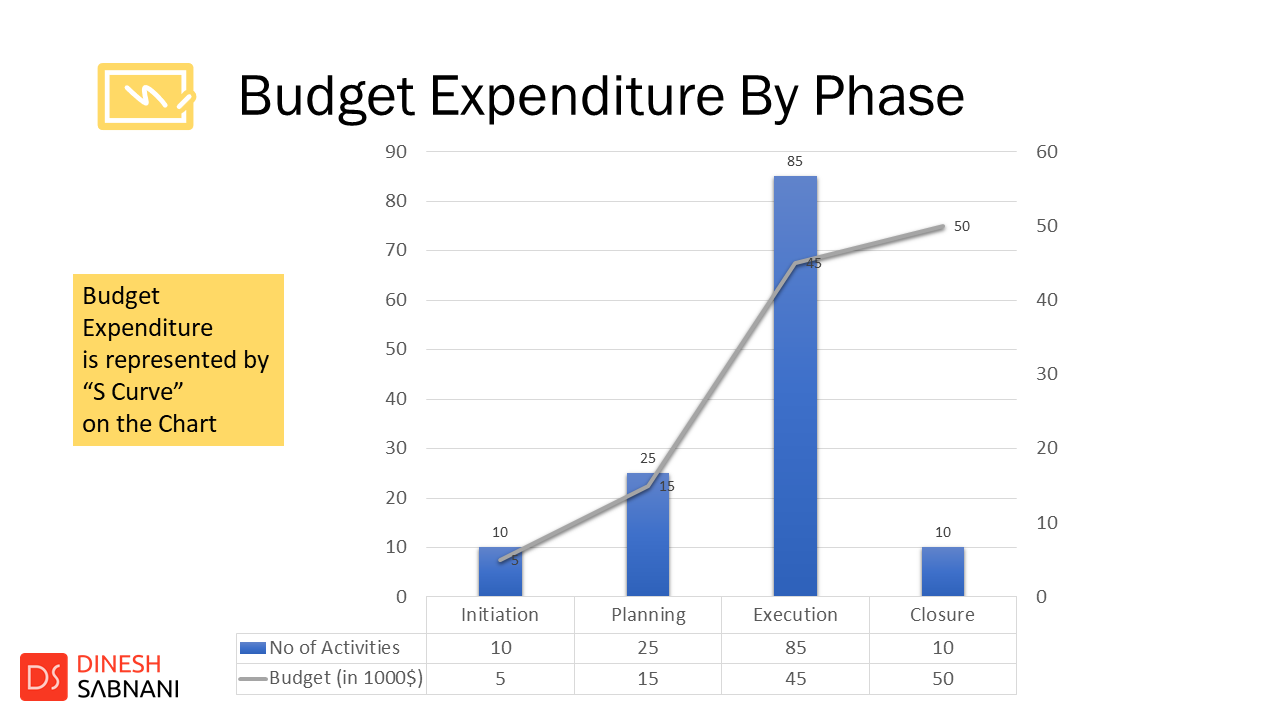
Now, it’s time to estimate the budget for each phase and plan the budget expenditure for each phase..
The no. of activities are gradually increased from Initiation to Execution and lastly few activities are left to be done in closure phase. Let’s apply the similar concept here, In relation with no of activities performed in each phase, the budget required in initiation phase will be less and increase gradually till the end of execution phase, and again budget is needed for closure.
The incremental utilization of budget is plotted in the graph and this graph is called as “S” curve, because it is shaped in the form of S letter. In the given example here, The total budget is 50,000 $. Ler’s how 50K$ is distributed. The budget assigned to each phase is corresponding to work performed in that phase.
The budget required for Initiation is 5K $, Planning = 10K$ that make total consumption till planning as 15K$, the execution phase reuires 30K$, that make total consumption till the end of execution = 45K$ and lastly 5000 $ needed for closure make the complete cost of 50K$ distributed across the phase.
Having phases also measures , how much budget is really required for each phase, and creates a kind of soft boundary within the project phases, so that unnecessary cost expenditure is controlled, and a dedicated amount is spent in each phase.
This is how, projects broken down into phases helps us to maintain right balance of work and budget needed for project activities.
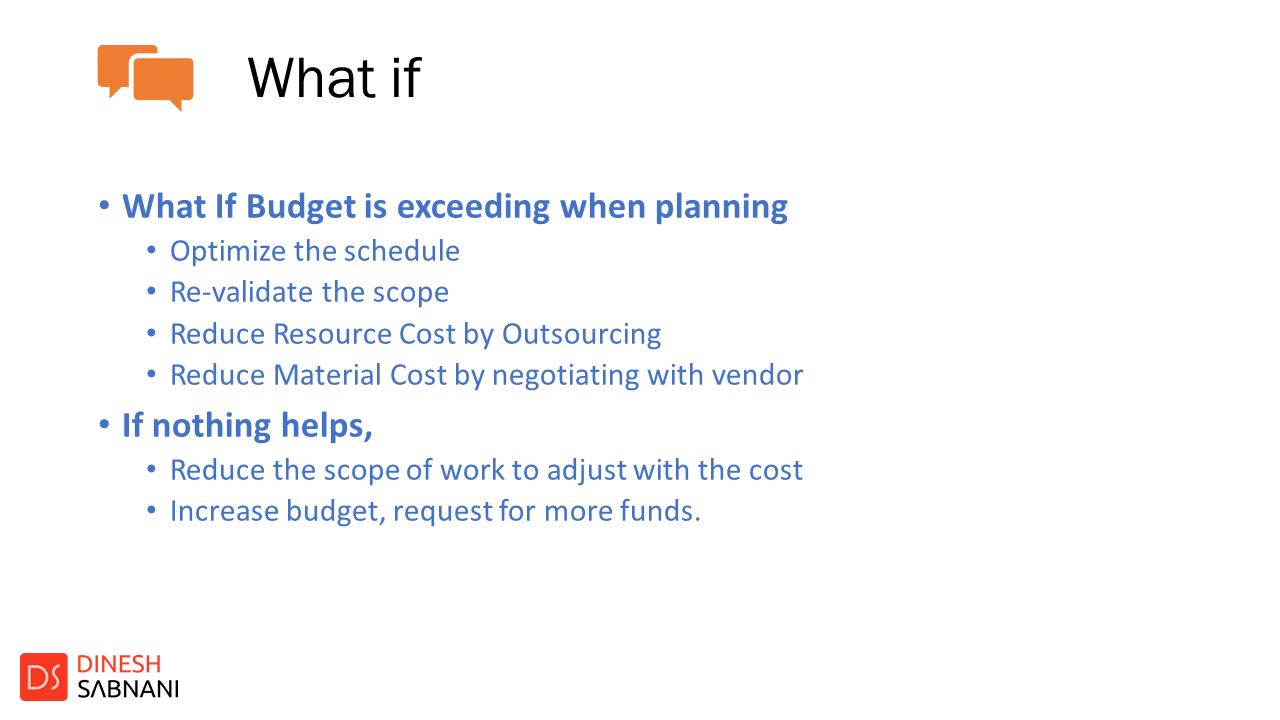
Now What if, in case we are short of money, here comes the real challenge, the first step for Project Manager will be to try to still make it happen in the given amount by the figuring out different options and alternatives such as Optimizing the schedule, Re-validate the scope, Reduce the resource cost by outsourcing or reduce material cost by negotiating with vendor.
After looking at all options in case it is still not possible to complete the project within budget, then we either reduce the scope or the request will be made to sponsor to fund project with more money, so that it can be completed.
The project sponsor is the one who is investing in the project, we also call them as investor. Sponsor owns the full power to put the project on hold, if it is not executing as per the plan / budget estimated for it.
For our story, It is Mr. Smith, who is the sponsor of the project lead by John.
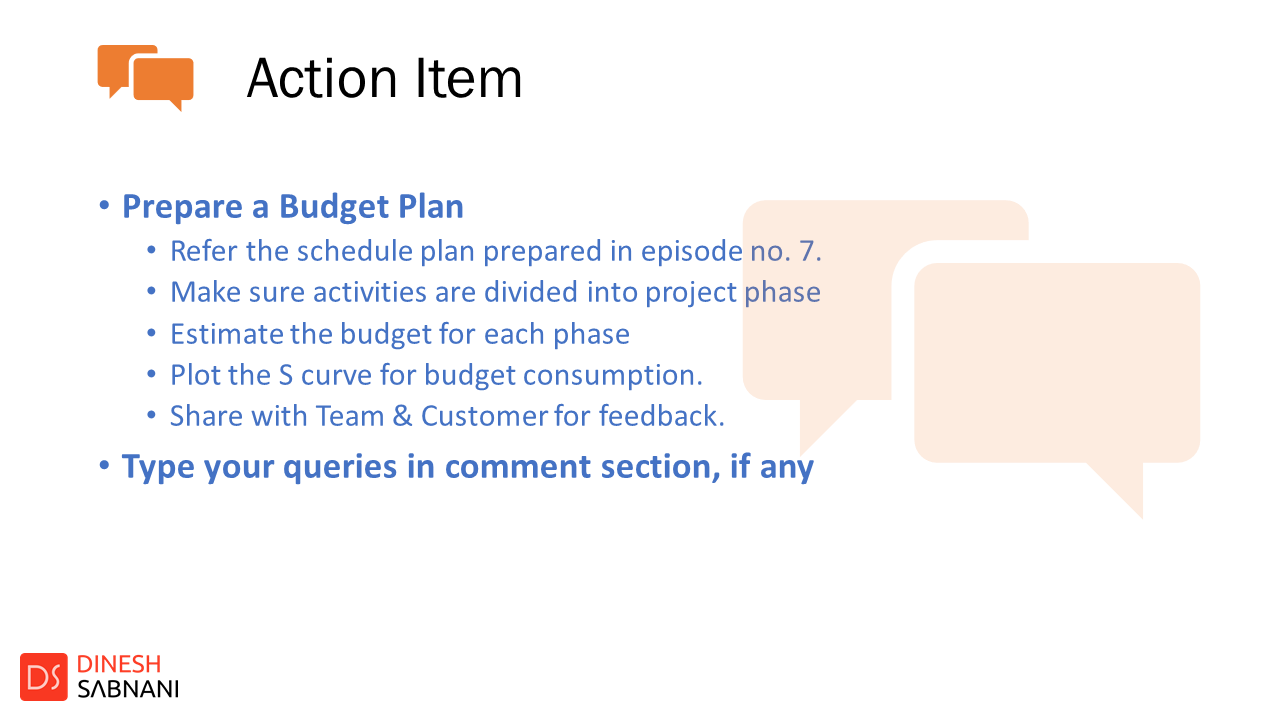
To create a budget plan
Make sure the schedule is prepared. make sure activities are divided into phases. Estimate the budget for each phase and plot the s cure for budget consumption. Finally share with the team for feedback.
So this was all about Budget Planning, you really need to come up with data points to plot the budget and form the S curve for your project. I understand, this can be slightly heavy when you do it for the first time but more and more practice will only make it easy for you.
With this blog, it completes the project parameters planning, for Scope (we build WBS), for time (we build Gantt Chart) and for Budget (we plotted the S curve).
Now next step is to onboard the team and get started with Project. In next blog, we will talk more about communication plan. Till then stay tuned.
Thank you all, That’s all for this Blog, Have a Great day, Bye Bye.


